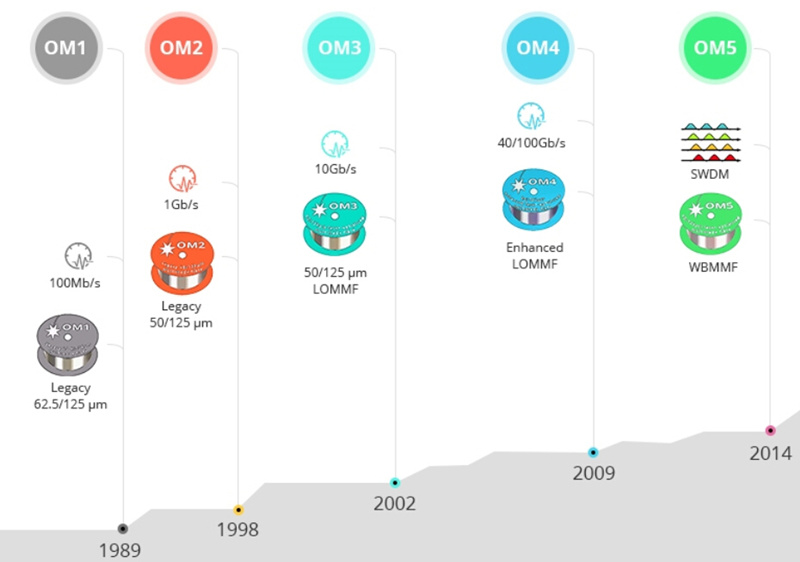Identified by ISO 11801 standard, multimode fiber optic cables can be classified into OM1 fiber, OM2 fiber, OM3 fiber, OM4 fiber and newly released OM5 fiber. The next part will compare these fibers from the side of core size, bandwidth, data rate, distance, color and optical source in details.

OM1 Fiber
OM1 fiber typically comes with an orange jacket and have a core size of 62.5 µm. It can support 10 Gigabit Ethernet at lengths of up to 33 meters. It is most commonly used for 100 Megabit Ethernet applications. This type commonly uses a LED light source.
OM2 Fiber
Likewise, OM2 fiber also comes with an orange jacket and uses a LED light source but with a smaller core size of 50 µm. It supports up to 10 Gigabit Ethernet at lengths up to 82 meters but is more commonly used for 1 Gigabit Ethernet applications.
OM3 Fiber
OM3 fiber comes with an aqua color jacket. Like the OM2, its core size is 50 µm, but the cable is optimized for laser based equipment. OM3 supports 10 Gigabit Ethernet at lengths up to 300 meters. Besides, OM3 is able to support 40 Gigabit and 100 Gigabit Ethernet up to 100 meters, however, 10 Gigabit Ethernet is most commonly used.
OM4 Fiber
OM4 fiber is completely backwards compatible with OM3 fiber and shares the same distinctive aqua jacket. OM4 was developed specifically for VSCEL laser transmission and allows 10 Gig/s link distances of up to 550m compared to 300M with OM3. And it’s able to run 40/100GB up to 150 meters utilizing a MPO connector.
OM5 Fiber
OM5 fiber, also known as WBMMF (wideband multimode fiber), is the newest type of multimode fiber, and it is backwards compatible with OM4. It has the same core size as OM2, OM3, and OM4. The color of OM5 fiber jacket was chosen as lime green. It is designed and specified to support at least four WDM channels at a minimum speed of 28Gbps per channel through the 850-953 nm window.
 汉信
汉信

